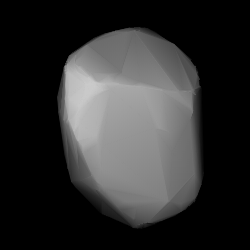328 Gudrun is a main-belt asteroid.
 Modelled shape of Gudrun from its lightcurve | |
| Discovery | |
|---|---|
| Discovered by | Max Wolf |
| Discovery site | Heidelberg Obs. |
| Discovery date | 18 March 1892 |
| Designations | |
| (328) Gudrun | |
| Pronunciation | /ˈɡʊdruːn/[1] |
Named after | Gudrun |
| Main belt | |
| Orbital characteristics[2] | |
| Epoch 31 July 2016 (JD 2457600.5) | |
| Uncertainty parameter 0 | |
| Observation arc | 104.41 yr (38135 d) |
| Aphelion | 3.43998 AU (514.614 Gm) |
| Perihelion | 2.78126 AU (416.071 Gm) |
| 3.11062 AU (465.342 Gm) | |
| Eccentricity | 0.10588 |
| 5.49 yr (2003.9 d) | |
| 325.246° | |
| 0° 10m 46.747s / day | |
| Inclination | 16.1164° |
| 352.328° | |
| 103.924° | |
| Physical characteristics | |
| Dimensions | 122.92±5.2 km[2] 122.59 ± 3.72 km[3] |
| Mass | (3.16 ± 0.46) × 1018 kg[3] |
Mean density | 3.27 ± 0.55 g/cm3[3] |
| 10.992 h (0.4580 d) | |
| 0.0425±0.004 | |
| 8.8 | |
It was discovered by Max Wolf on March 18, 1892, in Heidelberg.
Analysis of the light curve generated from photometric data collected in March 2012 provide a rotation period estimate of 10.992±0.002 h with a brightness variation of 0.32±0.02 in B magnitude.[4]
References
edit- ^ "Gudrun". Merriam-Webster.com Dictionary. Merriam-Webster.
- ^ a b "328 Gudrun". JPL Small-Body Database. NASA/Jet Propulsion Laboratory. Retrieved 11 May 2016.
- ^ a b c Carry, B. (December 2012), "Density of asteroids", Planetary and Space Science, vol. 73, pp. 98–118, arXiv:1203.4336, Bibcode:2012P&SS...73...98C, doi:10.1016/j.pss.2012.03.009. See Table 1.
- ^ Schmidt, Richard E. (July 2012), "The Rotation Period of 328 Gudrun", Bulletin of the Minor Planets Section of the Association of Lunar and Planetary Observers, vol. 39, no. 3, p. 109, Bibcode:2012MPBu...39..109S.
External links
edit- 328 Gudrun at AstDyS-2, Asteroids—Dynamic Site
- 328 Gudrun at the JPL Small-Body Database